







 

 
 
|
 |

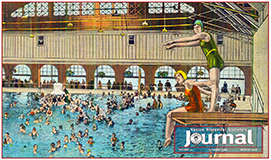 Celebrating over 32 Years!
Celebrating over 32 Years!
WINTER 2018. Volume 32
CELEBRATING VENICE LANDMARKS
Articles by Betsy Goldman & Stephen Pouliot
A brief history about The Venice Canal System, Venice Branch Library, Venice of America House & Venice Breakwater.
THE BOARDWALK BOYS
By Wendy Fairbanks
The Boardwalk Boys now spend much of their time in a 1928 brick building on
Abbot Kinney Boulevard. Bob and Mark Libow run Elco Welding where they invent
and re-use thousands of metal pieces. The brothers grew up in Venice and have some wonderful stories to tell.
They also provide free revisions up to 10 days after you place your order. You can even request to see your essay before you approve it. However, you need to do this within a 10-day grace period. LITTLE KNOWN PLACES IN VENICE
By Joan Del Monte
What do you mean it's only got one tree? Did you ever hear of a city park with one tree in the middle of a 20' circle? This piece of land happens to be an official city park.
|
2017 SPECIAL PRESERVATION ISSUE
FALL /WINTER 2017-18. Volume 31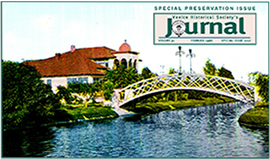
A CLOSER LOOK
By Sharon Cooper
What draws people to Venice? And how does it relate to historic preservation?
Did you know that historic preservation has economic and technical incentives?
Did you know that fraudulent demolition occurs in spite of Historic Cultural Monument status? This article answers these questions, and more, and informs you how important it is to preserve Venice's wonderful history.
Special Articles Included In This Issue
CITY OF LA SURVEY OF HISTORIC RESOURCES BEGAN 2007
THE MILLS ACT: Tax Breaks for Restoring Historic Properties
HELP PRESERVE THE HISTORIC CHARACTER OF VENICE
THE DIFFERENCE BETWEEN LOCAL, STATE & NATIONAL HISTORIC DESIGNATION
All these articles are designated to understanding historic preservation.
|
Celebrating our 30th Year!
WINTER 2016 – 2017. Volume 30
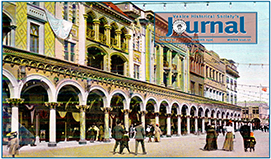 MUSCLE BEACH, CA MUSCLE BEACH, CA
By Joan Del Monte
Few humans know the focused intensity of bodybuilding better than the citizens of Venice CA. The area's international reputation draws bodybuilders from around the world to compete here. Joe Wheatley runs the bodybuilding competitions three holidays a year. The first Muscle Beach, in Santa Monica, closed in 1958. Since then Venice is the place and Muscle Beach has become a world-wide attraction.
A RED CAR ADVENTURE
By Wendy Fairbanks
This is the story of two Venice High School seniors and their ride through Venice on the historic Red Cars of Los Angeles. Eventually the ever popular Red Cars closed down as the buses and cars overtook the rails.
PROFILE OF A LEADING HISTORIAN
Reprinted and edited from an article in the Santa Monica Star by Miceala Shocklee
The New Year's Day Rose Bowl Parade was the initial hook that drew Glen Howell to Pasadena, California. Eventually Glen and his wife moved to the Westside and became active members of their community where Glen became an extraordinary asset to the Venice Historical Society. He hasn't stopped!
|
Celebrating our 30th Year!
SUMMER 2016. Volume 30
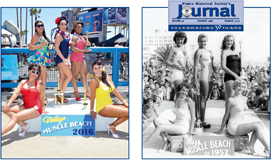 VENICE'S COLORFUL CHARACTERS & LEGENDS VENICE'S COLORFUL CHARACTERS & LEGENDS
By Joan Del Monte
George Freeth, A Young God With A Sunburn, Jake Cox, The Man Who Made Himself A Comet In A Chicken Suit, Tom Moran, A Legendary Venice Writer, Sarah Bernhardt, A Famous Venice Performer, James T. Peasgood, Jr, The Infamous City Clerk, Arnold Springer, A Professor Of History At Long Beach State & Venice Advocate, and The Igorottes, Phillippine Tribesmen Who Brought Local Color To Venice – all highlighted in our quarterly issue, and part of a book the VHS is publishing.
A SPECIAL TRIBUTE TO LONG-TIME VHS MEMBER RON ACCOSTA
By SMDP Writer Jack Neworth
Ron Accosta was an amateur historian of Ocean Park, Santa Monica and Venice. Read about his colorful life and how he became interested in our history. Ron sadly passed away in March. He will be missed.
|
Celebrating our 30th Year!
SPRING 2016. Volume 30
 A COWBOY CAME TO VENICE
A COWBOY CAME TO VENICE
By Delores Hanney
Those whose memories sweep back far enough to embrace that on-screen cowboy Hopalong Cassidy no doubt remember him as an upright hero-type nattily rigged out in bodacious black western wear – from knee-high boots to spendacious Stetson: an itinerant good guy with impeccable timing, arriving on a handsome white horse to save the day.
LAST RUN
By Delores Hanney, Research by Samara Jacobs
It was ghastly! Young race guy around town, Hal Shain, was zooming along with an alarming absence of due diligence, even by daredevil standards. As he drove too close to the top of the cup-shaped track – known as the Dare Devil Race for Life – his 2500-pound Haynes automobile smacked into a post and reared backward. It threw Shain down 20-feet to the cup's bottom, falling on top of him, leaving him horribly mangled.
SANTA MONICA CONSERVANCY SHINES WITH PRESERVATION OF SHOTGUN HOUSE
Reprinted courtesy of Hollywood Heritage, March 2016 Issue
Congratulations to our preservation partner, the Santa Monica Conservancy, on the opening of its Preservation Resource Center in what is believed to be Santa Monica's last shotgun house. A very rare property type on the West Coast, shotgun houses are a part of a southern vernacular closely associated with the development of New Orleans. The acquiring of this historic house took years and it was well worth Santa Monica Conservancy's mission.
|
Celebrating our 30th Year!
WINTER 2016. Volume 30
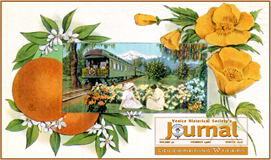 The Island The Island
By Delores Hanney & Research by Bill Hahn
It was a small lump of land triangulated by three of the original canals – the Lion, the Altair and the Cabrillo – in Abbot Kinney's Venice-of-America. In 1907 Kinney conceived the noble scheme to turn it into a botanical research station . This is the story of what became of Kinney's noble island.
Mary's Place
By Delores Hanney, Research by Tom Anderson
"It's so tucked away, like a speakeasy." It is indeed, tucked away. The hidden aspect of its entry configuration lends it a delicious air of the clandestine – a book lover's secret indulgence kind of rush. There is no secret about 'Small World Books' which originally opened in Marina del Rey. Now Venice is proud to have it.
Reprinted from the Venice Vanguard in 1924
Bailey Back to Face Trial After Eluding Law for Three Months
As suddenly and unexpectedly as he disappeared from his steel cage in the First National Bank of Venice early in July, Rubin R. Bailey, a 25-year-old former cashier of that institution, returned and surrendered himself after he vanished with missing bank funds – in the neighborhood of $40,000. What a journey he had before being convicted and taken to federal prison.
|
FALL 2015. Volume 29.
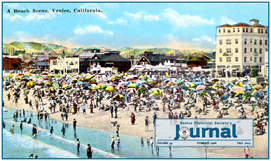 The Jewel of Ocean Front Walk: The Waldorf Hotel Story The Jewel of Ocean Front Walk: The Waldorf Hotel Story
By Bill Hahn & Delores Hanney
A century ago, May 8, 1915, a new 52-room hotel – christened the Waldorf – opened at Westminster and Ocean Front Walk in Venice. Here a doorman, who escorted them into the hotel's tastily appointed lobby, graciously greeted the guests. The Waldorf boosted an ocean view from every room and accommodations for bathers.
The Winebrenner Era
By Delores Hanney, Researched by Tom Anderson
His young son had asthma. California called. Harry Fielding Winebrenner packed less fame than Michelangelo certainly, but by the time he arrived to assume leadership of the Venice Union Polytechnic High School art department – in 1917 – this man already racked up a rather nifty rep as both teacher and artist. His impact on Venice was profound. He is best known for his sculpture in front of Venice High with Myrna Loy as the central figure.
Saluting an Unknown
By Delores Hanney
Charles Brittin wandered into Venice in 1951 and became an unconventional Beatnik. His photographs were praised as "incisive and powerful and poetic and tough".
|
SUMMER 2015. Volume 29.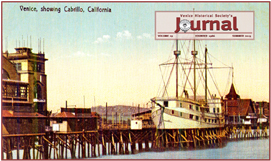
Boosting Business
By Delores Hanney
All for the betterment and elongatin of the seaside community of Venice. venicechamber.net
Abbot Kinney is chiefly remembered as the dreamer who whipped up an ersatz Venice, Italy out of a saltmarsh and a fantasy, but, he was also a businessman. Thus, it is not too surprising that he was a pioneer in the formation of a volunteer organization of business boosting eighteen months after the grand opening of Venice-of-America.. the model was the chamber of commerce.
Memories of a Venice Boyhood
By William Carroll
I remember a Venice of mythic wonders, enjoyed as never-ending opportunities for mischief, pleasures found nowhere else and random accomplishments of questionable value. Bill's own words tell you of his Venice that began in 1920. Excerpted from "The Lure of a Land by the Sea".
The Electriquette
By Delores Hanney
A short excerpt about the wicker pushchairs used on Venice Beach from 1916.
|
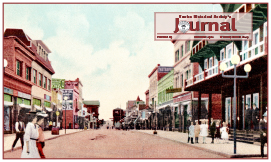 WINTER/SPRING 2015. Volume 29. WINTER/SPRING 2015. Volume 29.
Kids on a Roll
By Delores Hanney
Over the years, the Vanderbilt Cup Race was a big deal international automobile competition. It was inaugurated in 1904 by then 26-year old William Vanderbilt II. Initially it was laid out on public roads on Long Island, New York. A decade later the competition took place for the first time in Santa Monica. An interest was brewing for the Junior Vanderbilt Cup Races to be held in Venice one weekend in January. And so it was. Mack Sennett used this public occurance as a backdrop for his spontaneous movie shots shown in "Kid Auto Races" filmed on Main Street in Venice.
The Enticers
By Delores Hanney
Two and a half by four-inch photographic and lithographic souvenir cards of attractions and special events were commonly available as early as the mid-nineteenth century and awaiting the next stage of their evolution as commercially printed postcards. As the United States Post Office was trying to figure out a postcard definition, the cards exploded into a communication phenomenon. In 1916 the local Venice Chamber of Commerce observed "Postcard Day" February 19, 1916.
Where Was Barnes City?
By Glen Howell
Most people have never heard of Barnes City, and those who have, don't know where it was. It was the last incorporated city to be annexed to Los Angeles, but was it really a city? Barnes City was a political three-ring circus- a winter home for the Al Barnes Wild Animal Circus. This article tells the unique story of Barnes City taken from Venice Vanguard newspaper articles, 1926-1927.
|
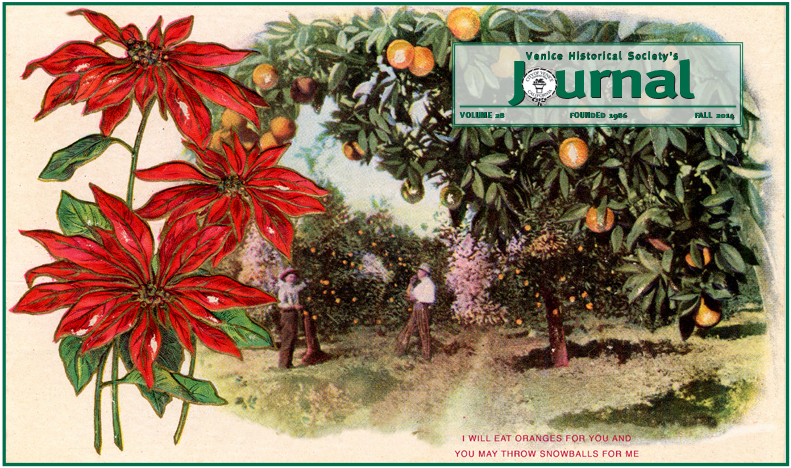 FALL 2014. Volume 28. FALL 2014. Volume 28.
Fun Park
By Delores Hanney
The just-published book, Pacific Ocean Park: The Rise and Fall of Los Angeles' Space Age Nautical Pleasure Pier written by Christopher Merritt and Domenic Priore, tell the story of these quintessential rides. The authors have produced an account of P.O.P. that is loaded with satisfying details. Their narrative is further advanced by an astounding abundance of images. Tastiest of all, a plethora of concept renderings by Dave Constable. Pacific Ocean Park was, briefly, a SoCal pop culture phenomenon.
An Act of Reinvention
By Delores Hanney
"Move your hands, move your toes, move any other damned thing you want but don't move your head," the artist growled at his subject. Self-reinvention was always a major motivator when artist Gil Borgos moved to Venice, California in the early 1970s. He would gain a certain renown and would come to be loved by his chosen community and affectionately dubbed the Mayor of Venice Beach in salute to his ubiquity.
Saving Neighborhood Character
Courtesy of Adrian Scott Fine, LA Conservancy News
As the economy continues to rebound, we are already beginning to see increased development pressures on older and historic neighborhoods. This is a problem, as these neighborhoods help define the city, and each has its own very distinct physical identity that is important to retain and celebrate. 'Mansionization' has come to Los Angeles and can be particularly damaging. The Los Angeles Conservancy is watching this process of the City's early stages of re:code LA, a comprehensive revison of LA's outdated zoning code. This article will help you learn more about neighborhood conservation.
|
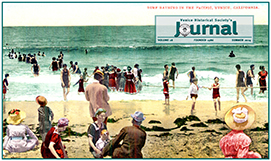 SUMMER 2014. Volume 28. SUMMER 2014. Volume 28.
Hot Rod
By Delores Hanney
They were a clutch of Venice High School guys whose cohesion and self-definition found its glue in a shared passion for hot rods. They called themselved The Igniters and Craig Breedlove, a setter of world land speed records, was among them.
Mack's Beauties
By Delores Hanney
Mack Sennett was the king of silly, evidenced by his letting loose on the world the likes of the Keystone Cops. In 1912, he came to Los Angeles to make pioneering silent screen comedies. Mack Sennett's Bathing Beauties loomed large on the Venice landscape.
New Venice Post Office To Be Dedicated
Reprinted from The Oarsman on February 7, 1940
Beloved principal Raymond E. Pollich, will represent Venice High School at the dedication. Also present will be Mr. Owen Kowen, Leo Strickland and John Dockweiler.
|
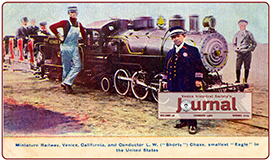 SPRING 2014. Volume 28. SPRING 2014. Volume 28.
Edward Biberman's Mural
By Delores Hanney
Since the recent slipping into private hands of the 1939 WPA-built post office in Venice, there has been anguish due to the loss of an almost constant availability of the pleasure afforded by an offhand gaze at its iconic mural, The Story of Venice, tucked inside the building. Read about the history of the Edward Biberman mural done in 1941.
The Daredevil Who Fell from the Sky
By Delores Hanney
An aero swashbuckler of the highest caliber, B.H. De Lay seemingly packed the precision of a neurosurgeon, the strategizing skills of an Army general, a choreographer's theatricality and nerves of steel. Before his tragic demise at the age of 31, De Lay had launched himself into aerial stunt crafting for the movies.
A Trip Back in History to Edward Clark, Venice High Principal
By Marilyn McClellan
In 1917, Edward Clark was appointed Supervising Principal of the junior and senior high schools of Venice Union Polytechnic High School, the original name for Venice High School. He served as principal for 19 years and retired in 1938.
|
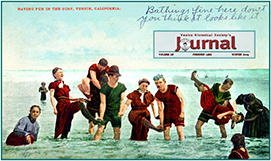 WINTER 2014. Volume 28. WINTER 2014. Volume 28.
Rider on the Storm
By Delores Hanney
He would have celebrated his 70th birthday in 2013 except that like his mega rock star peers, Janis Joplin and Jimi Hendrix, Jim Morrison was dead at the age of 27. Jim Morrison and his friends lived and wrote songs in Venice, eventually giving birth to the most provocative of rock bands, The Doors.
Memories of a Nonagenarian
By Delores Hanney
John Quincy Tabor, Jr. is a part of that sprawling, prominent Reece-Tabor clan from the bayous of Louisiana that seemed to be drawn to Venice, California. Tabor remembers family stories and how instrumental his family was in the early days of Venice.
The Pigeons of Venice
A short piece taken from the Venice Vanguard.
|
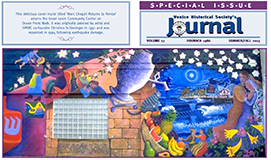 SPECIAL EXTENDED ISSUE • SUMMER/FALL 2013. Volume 27. SPECIAL EXTENDED ISSUE • SUMMER/FALL 2013. Volume 27.
Etude on Elders
By Delores Hanney
She poodled into Venice in 1972: a USC anthropologist on a mission. Dr. Barbara Myerhoff came to marinate in the essence of the poor and marginalized Jewish old folks who hung out at the Israel Levin Senior Center on Ocean Front Walk. For more than a decade, Myerhoff defined her presence at the Center, never to be duplicated.
A History of the Venice Police Department
By Bill Hahn
These articles were researched from the archives of the Venice Vanguard and the Santa Monica Outlook telling the story of the Venice Police Department, originally part of the Ocean Park Police Department, until 1911, when residents voted to become the independent city of Venice. The Venice Police Department is a story of 'firsts' for State of California.
The Miracle Man Cometh
By Delores Hanney
In the summer of 1921 a faith healer came to Venice. His presence would throw the spotlight on our little city like nothing that preceded the affair had ever done, according to the advance announcement appearing in the Venice Vanguard on June 29th of that year. Charismatic Brother Isaiah had arrived.
|
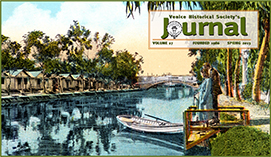 SPRING 2013. Volume 27. SPRING 2013. Volume 27.
You Saw It Here First
By Delores Hanney
Marilyn Slater, possessed of degree in anthropology from UCLA, discovered this
lost gem of Venice movie-making history. It was announced in a special edition of The Photoplayers' Weekly of July 21, 1915, of the filiming of a great serial titled
The Broken Coin. This issue commenced with a rah-rah announcement of the filming to take place in Venice on July 25th. Some of the most thrilling scenes in this serial were filmed in Venice. The Weekly prophesized 'the largest number of
people ever assembled in the world to see movie pictures in the making.'
The Dream Spinner
By Delores Hanney
The man who would one day spin Venice-of-America from the sinuous strands of a dream into a curious reality, even as a kid possessed a restless, busy mind. Sickly with asthma, Abbot Kinney read voraciously to slake his unquenchable thirst for knowledge. Like so many others during the last two decades of the 1800s, Kinney came to Southern California as a wellness seeker. What was once a soggy marsh, the development and shepherding of Venice-of-America would be the main focus of the last sixteen years of his life. Abbot Kinney was the source, the metaphoric sea from which Venus – in the form of Venice-of-America – arose in her full radiant glory. Then Venice morphed on.
A Matter of Diplomacy - U.S. Pacific Fleet Visits Venice
By William Hahn
A photograph was donated to the Venice Historical Society but no one knew its history. It peaked the interest of long-time member Bill Hahn, who immediately started researching this amazing donation. What he discovered was a wonderful story of U.S. diplomacy and Venice was foremost on the list. Warships were to visit Venice, Ocean Park and Santa Monica in March of 1908.
|
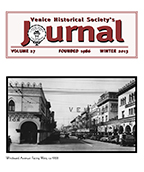 WINTER 2013. Volume 27. WINTER 2013. Volume 27.
Refuge on Rindge Street
By Delores Hanney
It's a Venice story. It's a Hollywood story. It's the story of a love affair but not, precisely, a love story. It's the story of movie actors Loretta Young and Clark Gable and their not-so-secret spawn, Judy Lewis, who drew her first breath beneath the roof of a small rental house owned by her grandmother on Rindge Street in Venice on November 6, 1935. The two stars were burning brightly when they came together
for the first time to make "The Call of the Wild" with Jack Oakie. From there our 'love' story continues...
A Certain Scent of Noir
By Delores Hanney
Back in the 1920s and 30s LA throbbed with the hardboiled urgency after which writer Raymond Chandler patterned his pungent fiction of the milieu's mean streets, where supposed law-enforcers were corrupt as the thugs. Tony Cornero was part of that intensely charged atmosphere. Clandestinely carting high-end Scotch whiskey from Canada into Southern California – via a fleet of fast boats – made him filthy rich . With evasive moves worthy of the escape sequence in an adventure film, he always avoided capture on his sea-riding casino, the Rex, off-shore just outside Santa Monica Bay.
The Lure of a Land by the Sea
A Book Review by Greta Cobar
Long-time Venice Historian Delores Hanney did it again; published yet another wonderful Venice memoir, made up of over thirty "vignettes," as she calls them. She tells funny and insightful stories from the times of Abbot Kinney's arrival in Venice all the way to more recent events that long-timers might remember. From inspirational stories of nation-wide relevance to funny anecdotes that might make you start laughing out loud as you are quietly reading from one chapter to the next. Hanney's vignettes abound, entertain, inform and mesmerize. Her book tells so many stories, divulges so many secrets, and sheds light on so much history. The book is sold at Small World Books on Ocean Front Walk and Beyond Baroque on Venice Blvd.
|
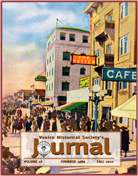 FALL 2012. Volume 26. FALL 2012. Volume 26.
A Venice Centennial
By Delores Hanney
The first whisper of it came on April 14, 1912 via a little Venice Vanguard announcement of a brand new enterprise fixing to take form in Venice, California - a four-story rooming house called the Potter. The building is celebrating one hundred years and still operates as a rooming house of sorts.
Phillumenology
By Delores Hanney
Back in the 1960s lots of folks had way-over-sized brandy snifters or some such vessel parked on their coffee tables as a receptacle for a big bunch of matchbooks. The matchbook concept leapt from the mind of man to a position in reality's realm when a Philadelphia lawyer brought forth the paper match created from thin strips of cardboard. The history is fascinating as are the examples of Venice matchbooks displayed in this article.
Saving the Historic Post Office
By Adrian Scott Fine
The historic Venice Post Office at 1601 Main Street has become a poster child for the current national plight of the United States Postal Service. While the Venice Post Office fortunately has a preservation-minded buyer, film producer Joel Silver, it exemplifies the complexities involved in preserving one of America's great building types. The story of the fight to save the Venice Post Office is one of notability.
|
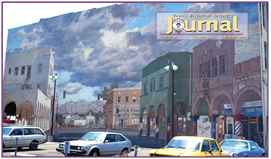 SUMMER 2012. Volume 26. SUMMER 2012. Volume 26.
A Mural and A Movie
By Delores Hanney
There's a new mural in Venice. It holds sway from the east-facing exterior wall of Danny's on Windward Avenue and even on a sunny afternoon its image smolders with sinister darkness, literally breathtaking in the atmospheric vibe it exudes. It is a tribute to a great filmmaker and the artist who painted it.
Pix of the Past
By Delores Hanney
When he was in the third grade, Alan Reginald Stacey moved, with his parents, to Venice, California, where they would live in at least four different homes. The year was 1926. Thanks to Alan's daughters, Marilyn Stacey, Chris Stacey and Kathy Stacey Hall, we have an enchanting little collection of snapshots to savor, illustrating his iconic Venice boyhood.
Amazing Acquisitions
Friends of Will Raabe, owner of The Comeback Inn in Venice, have donated a huge scrapbook chronicling the wonderful history of the local hangout. Over 350 artifacts, dated around 1924 to 1949, have been recovered from a city project on Rose Avenue and donated to VHS. This marvelous and telltale collection will be the subject of a future meeting.
|
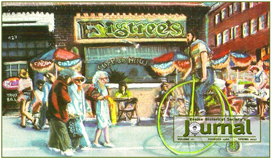 SPRING 2012. Volume 26. SPRING 2012. Volume 26.
Bathing Beauties Were Best
By William Carroll
For photographers participating in Venice's passion for publicity, presenting lovely young ladies on peaceful beach sand was the best of all assignments. A story by photographer Bill Carroll, who photographed countless Venice beauty pageants in the 1930s.
The Galleon & The Gambler
By Delores Hanney
It was ready for the July 4th, 1905 grand opening of Venice-of-America when 40,000 people poured into the new resort community by the sea; proudly riding the Pacific from its unlikely perch atop the Abbot Kinney Pier, a magnificent– if
make-believe– galleon. It was the famous and notorious Ship Café.
What's a Shotgun House?
By Sherrill Kushner
Elvis Presley lived in one, New Orleans is known for them, and Ocean Park used to have many. Now the Santa Monica Conservancy is rehabbing one of the last intact Shotgun Houses and turning it into a Preservation Resource Center.
|
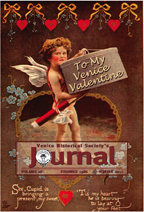 WINTER 2012. Volume 26. WINTER 2012. Volume 26.
Lions & Tigers & Bears, Oh My!
By Delores Hanney
Alpheus George Barnes Stonehouse had a special affinity with the four-footed ones of the earth. For some men this might have translated into life as a sheep shearer, contrarily he was the owner of the Al G. Barnes Circus & Wild Animal Zoo. Abbot Kinney invited the circus to winter in Venice in 1911 because it was the most popular type of public amusement.
Scott Joplin's Disciple
By Delores Hanney
Even in a place as well stocked with eccentrics as Venice, Sanford Brunson Campbell stood out as a character. He took up residence in the mid-1920s and opened a barbershop at 711 Venice Boulevard. Chasing after his dream, in 1899, at the age of 15 Campbell ran away from home and family. Eventually he established an acquaintanceship with a colleague of Scott Joplin's. This commenced a life-long obsession to play ragtime.
Celebrating the Holiday Season
Several VHS photos are displayed involving our year-end events- a Myrna Loy quarterly lecture, a holiday boutique sale and a Venice Chamber mixer.
|
FALL 2011. Volume 25. 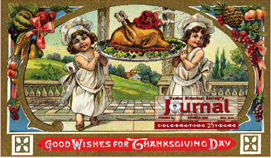
Celebrating Our 25th Anniversary
Suffragists at the Seashore
By Delores Hanney
The opinionated developer of Venice, California matched action to thought in producing a "Suffrage Day" program held in the new 3600-seat auditorium on August 1, 1905. The line up included Susan B. Anthony, Reverend Anna Shaw and Caroline Severance. Unearthed from an early Venice Daily Vanguard was a photograph and real proof of Kinney's contributing support for equal suffrage.
Vitalizing the Vision
By Delores Hanney
In Abbot Kinney - a man of brains and range and passion - the engineerng solution to a land development dilemma exploded into a dream: Venice-of-America. Kinney invited architects Norman Foote Marsh and C.H. Russell to be the vision vitalizers who would bring the quixotic dream into real life existence. In only 12 months, Marsh and Russell had designed most of the significant buildings in Venice.
A Part of the Westside Turns 40
In recognition and celebration of The Argonaut newpaper's 40th anniversary a book, "Snoopin' Around," is being released about David Asper Johnson's launching of The Argonaut in 1971. The book tells the story of the early years of the paper and the development of the Marina.
|
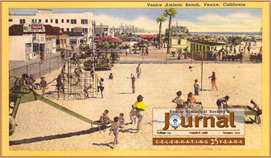 SUMMER 2011. Volume 25. SUMMER 2011. Volume 25.
Celebrating Our 25th Anniversary
Infectious Tsunami
By Delores Hanney
It was the greatest health disaster in all of history. It crashed over continents like killer tsunamis and before it was over it had caused fifty to a hundred million people to forevermore be spoken of in the past tense. Usually referred to as the Swine Flu or Spanish Flu, the 1918 influenza pandemic didn't skip Venice, California.
Founding Father
By Delores Hanney
This year is the Venice Historical Society's twenty-fifth anniversary. Long overdue in formation, in 1986 a wee crowd of the conservation-minded broke through the apathy to take up the task of preserving the history of this community. That the history-saving society materialized was due to the effort of Don Tollefson, who leapt into the void to assume the lead. This is an article about Don's vision and his passion.
Historic Gondola Returns to Venice at the Former Site of the Famed Grand Lagoon
Eighty years after the last canals were drained and filled in to make way for automobiles, the Venice Historical Society returned a treasured artifact to its rightful location.
|
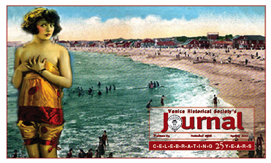 SPRING 2011. Volume 25. SPRING 2011. Volume 25.
Celebrating Our 25th Anniversary
Road Race
By Delores Hanney
The fathers of Venice, in the spring of 1915, decided to have a daring road race. Speed was taken seriously in Venice. Why not have a ripping race, on motorcycles, taking place along Washington Boulevard to Rose Avenue to Compton Avenue- now Lincoln Boulevard- and returning to Washington Boulevard. Ninety-seven laps equaled 300 miles. This was the beginning of Harley-Davidson's presence in Venice.
In Venice, Enforcing The Law From On High
By Steve Harvey
When Swede Meyerhofer joined the Venice police in 1919, he predicted that few prisoners would try to jump from his vehicle. That's because his vehicle was an 8-cyclinder biplane. He was the first member of Venice's Aero Police and one of the first sky cops in the nation. The Venice Evening Vanguard newspaper wrote that the formation of the Aero Police was "probably one of the most original and world-beating stunts ever pulled off in California."
Painting the Town
By Delores Hanney
It is more than thirty years ago now that he breezed into town with public art on his mind. Already Rip Cronk had earned a reputation as a muralist of consequence. Murals, of course, are a distinguishing component of Venice's kinky savoir-faire. Rip Cronk's murals add incredible beauty and depth to the landscape.
|
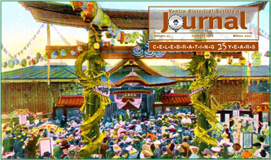 WINTER 2011. Volume 25. WINTER 2011. Volume 25.
Celebrating Our 25th Anniversary
Of Sweet Dreams & Sandcastles
By Delores Hanney
From the very beginning there was a Japanese presence in Venice, California. Planted on the Abbot Kinney Pier, it took the form of a Japanese Pavilion and was a stunning expression of Kinney's admiration for that culture. The Japanese immigrated to Venice and embraced this new land.
Wizard
By Delores Hanney
Arthur Reese arrived in Los Angeles and recognized it as a promising place for a bright, energetic young black man with an entrepreneurial zeal to be uncorked. He was the first black businessman in Venice.
Life in Venice
By Delores Hanney
Back in 1936 Henry Luce took a notion to bring out not just a new magazine, but instead an oversized, whole new KIND of magazine. He fancied the name "Life" for his proposed publication. Venice was featured in this iconic magazine on January 22, 1940.
|
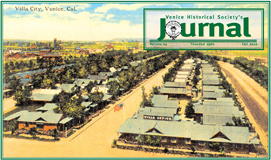 FALL 2010. Volume 24 FALL 2010. Volume 24
The Guy from Villa City
By Delores Hanney
This is a story about Bill Carroll and his memories of living in Villa City, Venice, CA. At 95, his memory is still as sharp as crocodile teeth. His boyhood in Venice made an admiral apprenticeship for all his blitzing about, living life to its fullest. He was still a toddler when his mother assumed management of Villa City, the sprawling tent complex tucked up next to the Grand Canal.
Bungalows by the Book
By Laura Meyers
A century ago, Los Angeles architect Frank M. Tyler was making a name for himself as a popular designer in the Craftsman Bungalow style, often with Tudor influences. This article tells of the history of the Bungalow which can be seen all over the Westside.
A New Volume in Venice
By Delores Hanney
A review about the book Cottages in the Sun: Bungalows of Venice, California, a dishy consideration of 28 Venice homes existing in the early twentieth century and how they've turned their alluring faces towards the twenty-first century sun.
The Story of Old Westminster
By O.W. van Petten
Courtesy of Todd Lesner
When at the dawn of this century Old Westminster School first opened its doors Venice was still the paradise at the end of the Pacific Electric Line. Martha Washington Grammer School, as Westminster was known for many years, was designed to be the cultural nexus of the community.
First Years in Venice
By Dolores Montgomery
Dolores, born in 1929, remembers her teachers and years as a pupil in the oldest grammer school in Venice - Westminster Avenue Elementary School, formally Martha Washington School.
|
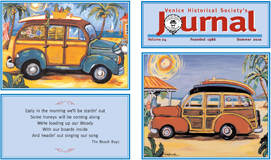 SUMMER 2010. Volume 24 SUMMER 2010. Volume 24
Wave Riders
By Delores Hanney
Bill Gould began, as a lad, watching older guys surf at the south side of Venice Beach. Chip Miller began surfing at the north end of Venice Beach at age 11. Both surfing began their love of riding waves in the 50s and 60s. The very first Venice surfer was here in 1907, a Hawaiian Islander named George Freeth.
Bill Hahn Remembers
By Delores Hanney
Scouting was a significant element of Bill Hahn's boyhood, most especially, Sea Scouting. This article is an account of the history of his Sea Scouting years from 1928-1949.
The Myrna Loy Statue Returns to Venice High
An excited crowd of 1,800 alumni, students, faculty and locals assembled on the front lawn of Venice High School on Saturday, April 10, as a new incarnation of the school's legendary statue of Myrna Loy was unveiled.
|
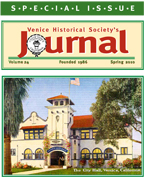 SPRING 2010 - A SPECIAL ISSUE. Volume 24 SPRING 2010 - A SPECIAL ISSUE. Volume 24
Avatar
By Delores Hanney
George Drury Smith, a traveler, a linguist, a teacher of languages and a poet, longed for a literary community. In 1968, Beyond Baroque came into being in a modest building on what is now Abbot Kinney Boulevard. Beneath Beyond Baroque's umbrella, there were workshops, readings, printing, pre-publication support, a small press, a library, galleries and even music recitals.
The Beat of the Bongo
By Delores Hanney
It was a movement. Like Cubism. And like Cubism it was about experimentation and expression and was scorned. The principles of the Beat movement consisted of these: hanging out and heavy thinking and communicating. The main strongholds of Beatdom were New York's Greenwich Village and San Francisco's North Beach, but it was practically ordained that an outpost would take root in Venice.
A Philomene Rhapsody
By Delores Hanney
More than two years after the passing of Philomene Long, the silence of her absence from the streets and the sand of her cherished Venice milieu, still echoes like a great mournful wail.
|
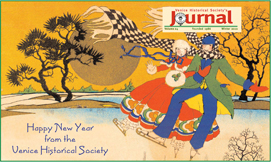 WINTER 2010. Volume 24 WINTER 2010. Volume 24
The Holiday Season in Venice - 1915
By Mary Jane Weil
In 1915, Abbot Kinney made sure that Christmas Day in Venice was a day to be remembered. Mr. Kinney was on hand to supervise Santa Claus who distributed 5000 packages to children on the beach. New Year's was celebrated with spectacular festivities welcoming in 1916.
The Drama Queen
By Delores Hanney
Sarah Bernhardt's 1906 Farewell America Tour was neither the first nor the last U.S. "farewell tour" but it was the only time the legend appeared in Venice.
The SoCal Vernacular
By Delores Hanney
Whatever you call vernacular architecture, it's kitsch in the first degree. California was not actually its birthplace but it became its most natural setting. The 1920s and '30s became the golden age of this eccentric architectural form.
|
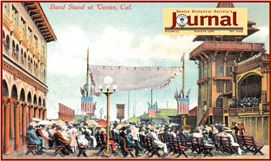 FALL 2009. Volume 23 FALL 2009. Volume 23
Ray Bradbury Adopt-a-Colonnade Restoration Project
By Betsy Goldman
(This issue contains a special insert with photographs from the Restoration Project)
Close your eyes and imagine a street lined on both sides by three-story hotels designed to capture the flavor of the Italian Venice featuring an ornate mix of Byzantine and Renaissance influence with distinctive colonnades. That was Windward Avenue in 1925. This article deals with the history of the landmark Venice colonnades.
Desperate Dancing
By Delores Hanney
During the mapcap Roaring Twenties marathon dancing gurgled up from the same pond of goofy high spirits that spewed forth such dippy activities as flagpole sitting, competitive egg-eating, endurance kissing and swallowing goldfish. This article shows marathon dancing in Venice as theatrical affairs.
The Devotee's Labyrinth
By Delores Hanney
An article dedicated to Venice devotee Pat Hartman. She reads about it, writes about it, paints it and serves as handmaiden-in-charge of an online shrine for its veneration.
|
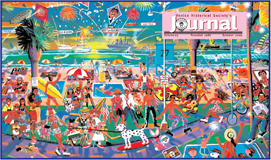 SUMMER 2009. Volume 23 SUMMER 2009. Volume 23
Ray Bradbury's Venice
By Delores Hanney
Ray Bradbury is, of course, most revered for his ingenious fiction of the speculative sort; some of it – most notably The Martian Chronicles – was created while he was a resident of Venice between 1941 and 1950.
The History of the California Orange & Abbot Kinney the Horticulturist
Introduction by David Boule
Abbot Kinney the Horticulturist by Glen Howell
The origin of the orange is somewhat obscure. Some insist they came from India, others claim they originated in China. It was Franciscan Friar Junipero Serra who introduced the orange into then Spanish-owned California in 1769. Abbot Kinney was a man of many accomplishments. Because of his interest in improving blood oranges, he became well known by citrus growers all over California.
A Life Beside the Bay
By Delores Hanney
Her brain bubbles over with uncontainable memories of her tenure in Venice, which began a year after her birth in 1929. Dolores Montgomery is a compulsive story-teller with an evangelist's zeal for yarning about Venice.
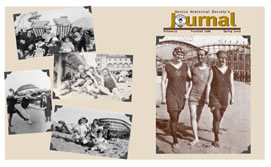 SPRING 2009. Volume 23 SPRING 2009. Volume 23
Venice Courts Immortalize Early Black Residents
By Betsy Goldman
At one time in Venice there were streets named W. Washington Boulevard, Washington Way, Washington Boulevard and Washington Street. Not any more. Venice has acknowledged Oakwood's history, in its street names and its courts, as well as recognizing that Venice had African-American residents from the time of its 'founding.'
Venice Breakwater
By Betsy Goldman
Recently I was asked to name my favorite historic fact about Venice. If you go the end of Windward Avenue and continue on the beach until you come to the edge, you'll see a group of rocks. The history of these rocks began in 1904.
Flooding & Storms Threaten Venice - 1914
During January 1914, several vicious storms hit Venice. This article reflects on these
stories and shows the damage in some incredible pictures.
Bungalows at the Beach
Many of the early visitors to Venice-of-America were day-trippers who'd taken the trolley
from Los Angeles just to spend the day at the beach. For others, Venice was a longer
stay and had to create Villa City to accomodate the visitors.
History of the Venice Pavilion at the Beach
By Beau Dakota Berdahl
When you walk toward the ocean on Windward Avenue, you find yourself standing on a
very different plot of land than originally planned. This is where the Venice Pavilion once
stood from 1960 until 2000. |
|
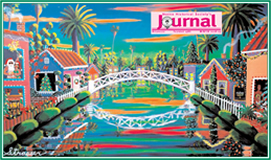 WINTER 2008-09. Volume 22 WINTER 2008-09. Volume 22
Miss Muscle Beach 1948 Honored in Venice
By Delores Hanney
At 77, all petite and pink and perky and topped
by a little halo of spun-sunlight hair, Sara Hirsch Clark may seem an unlikely inductee into the Muscle Beach Hall of Fame. But, there she was this past Labor Day, taking her place amongst other Muscle Beach legends.
Christmas Spirit of 1918 - A Poem by Abbot Kinney
Abbot Kinney knew how to throw a party and Christmas 1918 was no exception. Although the year had brought with it the influenza epidemic and the effects of World War I, people still eagerly came out to celebrate the holiday in Venice.
Venice Daredevils
Airplane stunts were a big draw at Venice Beach. In 1921, Venice local Babe Kalishek was 18 years old. She had never had any special athletic training. She'd only been in a plane three times when she decided to walk out on one of the wings.
|
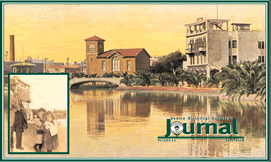 FALL 2008. Volume 22 FALL 2008. Volume 22
Kinney-Tabor House Granted Historic Cultural Status
A Venice craftsman-style home linked to the community's founder Abbot Kinney and
his friend and personal assistant Irving Tabor, has been added to the list of
Historic-Cultural Monuments in Los Angeles.
The History of Fighting Fire in Venice
By Chin Thammasaengsri
Before Los Angeles became a major city covering 400 square miles, Venice had its own fire department that consisted of two stations. Venice Fire Station 1 opened in 1905.
Now Appearing
By Delores Hanney
It's not a cushy life. At 62 he still makes the rent by huffing and puffing, moving and hauling. But evenings and weekends you can find Peter Demian on Ocean Front Walk making his music, living his dream.
Venice Tigers Roar into Town
Article compiled by Mary Jane Weil from information
donated by Greg Flewin
The year was 1913. Baseball was becoming the all-American sport. Around 1909, the Pacific Coast League decided to expand and created a team in Vernon. Within a few years, Vernon was no longer a suitable home for a respectable ball team so the beach town of Venice, with its amusements and crowds, seemed like a perfect fit.
|
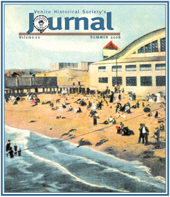 SUMMER 2008. Volume 22 SUMMER 2008. Volume 22
The Most Famous Road in the World
Route 66 first ended at 7th & Broadway in downtown
Los Angeles. Later it ended at Olympic & Lincoln and still does
today. The article explains what has made historic Route 66 a national/international icon.
That Lanky Brunette with a Wicked Jaw
Myrna Loy distinguished herself as the student who posed for
the sculpture in the fountain that welcomed all to Venice High School. After she was plucked from the silent movies and played
vamps and tramps in nearly 70 films, her real movie career
began as the female lead in The Thin Man.
Return of the Myrna Loy Statue
Thanks to extensive fundraising efforts by the Venice High School Alumni Association, a
new Myrna Loy statue is set to come back to the high school.
How a Venice Grocery Store Turned into a Popular Hangout
In 1915, Caesar Menotti built a grocery store in a 2-story building at 52 Windward Avenue.
Soon after it opened, the grocery was converted into a bar and grille. The history of this
establishment has survived many tumultuous years.
|
| |
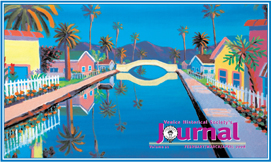 February/March/April 2008. Volume 22 February/March/April 2008. Volume 22
Venice Post Office Dedication
The Venice Post Office mural, titled "Story of Venice" by artist Edward Biberman, was never formally dedicated in 1941. A special program took place in November of last year to finally dedicate this wonderful depiction of Venice's first thirty years.
The Israel Levin Senior Center
The beautiful Isreal Levin Senior Center, established in 1964, was originally a bingo
parlor on Ocean Front Walk. Today there are approximately 175 members who
attend the center's programs.
The Beginning of Venice High School & A Family History
The formal beginning of the Venice Union Polytechnic High School opened on
September 11, 1911 in the old Venice Bath House, with the pool drained
and boarded over. Wonderful vintage photos show students and workers
lined up by the lagoon in front of the HIgh School.
|
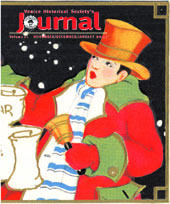
November/December/January 2007-2008. Volume 22
The History of the Greeting Card
The cards that grace our Journal covers every issue have a wonderful history dating back over 100 years.
Hoppyland
One of the first theme parks in the country named after the famous cowboy star, Hoppalong Cassidy.
Ink Well Beach
Santa Monica recognizes the first surfing beach for African Americans. This was a big hangout for Venice surfers.
Helms Bakery
An in-depth look at the Venice bakery that was so popular for many years.
|
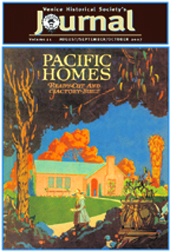 August/September/October 2007. Volume 21 August/September/October 2007. Volume 21
Mar Vista, Venice's Neighbor to the East
Venice and Mar Vista share a common border. This article traces the 80 year history of Mar Vista which recently celebrated its 80th birthday. The Mar Vista community was once known as Ocean Park Heights until the 20s. Vintage photos show businesses and homes, some of which are still standing.
Houses That Sears Built
Guest author and 'Kit Home' mavin, Rose Thorton, tell us everything we wanted to know about Sears Kit Homes and Pacific Ready Cut Homes which were sold via mail order catalogs and shipped to homeowners all over the Los Angeles area, including Venice, in about 10,000 pieces. Hundreds of these wonderful, architecturally significant homes still exist today.
Aimee Goes Missing
This article, written by frequent guest author, Delores Hanney, gives us a wonderful
account of the famous evangelist, Aimee Semple McPherson, who disappeared on
May 18, 1926, under mysterious circumstances.
|
 May/June/July 2007. Volume 21 May/June/July 2007. Volume 21
SPECIAL PRESERVATION ISSUE
City of LA Begins Survey of Historic Resources
The City of Los Angeles has been approved by the State Office
of Historic Preservation as a 'Certified Local Government.' This makes the city eligible for state and federal historic preservation grants.
The Mills Act
This program allows tax breaks for restoring historic properties.
Historic Designation: Local, State, National
This article shows the difference and the criteria used between local, state and national designation.
|
 Feb/Mar/Apr 2007. Volume 21 Feb/Mar/Apr 2007. Volume 21
Pacific Ocean Park
A Short-Lived Wonderland
By David Doherty
The brief twenty year life of "Pacific Ocean Park" or "POP" is a roller coaster of classic Southern California legend. A saga complete with Movie Stars, Political Scandals, Rock 'n' Roll and, even as a burned out derelict, the birthplace of the internationally known "Dogtown Culture" of surfing and skateboards.
In its glory days "POP" was a living diorama of the energy and aspirations of the "Atomic" entertainment culture. The new medium of television realized in a dimensional playground! "Pacific Ocean Park" is as important of a cultural landmark to mid-century Southern California life as "Coney Island" is remembered by native New Yorkers of its era. And considering that it was a more casual atmosphere, and cheaper than "Disneyland," its audience was truly of the "everyman" status.
The significance of "POP" in the history of entertainment design, is substantial. For instance, in comparison to "Disneyland", which relies on a sense of "nostalgia" as its medium, "POP" was a celebration and vision of its time! It was a densely expressive and energized 26 acre environment! From the giant starfish cloistered entrance to the "Banana Train Ride," at its end, there were turning neon pinwheel signs, "Flying Fish" and a great grinning Octopus on the midway. These mechanized distractions challenged you "there and then" rather than relying on "Remember when?" "POP" was an Oceanic Wonderland of sensory invasion and overload.
|
|
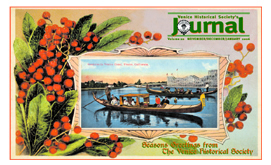 Nov/Dec/Jan 2006-2007. Volume 20 Nov/Dec/Jan 2006-2007. Volume 20
Mabel and Fatty Swam at Venice Beach
During the years before air conditioning, it was common for the film colony to migrate to the beach. This article is about Keystone Comedy stars Mabel Normand and Fatty Arbuckle.
Oil Fever
This 1929 article deals with oil wells inundating Venice Beach.
100 Years Ago In Venice
News taken from 1906
|
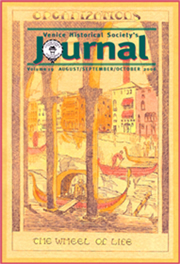 Aug/Sept/Oct 2006. Volume 20 Aug/Sept/Oct 2006. Volume 20
Venice Historical Society Celebrates Its 20th Anniversary
By Betsy Goldman
In May of 1986 there was a small announcement in the Los Angeles Times. It was a call to form a Venice Historical Society. The driving force was Don Tollefson, president from 1986 to 1988 and from 1994 to 1998, who was a member of the Los Angeles Conservancy.
The first meeting in September 1986 raised seed money. Nine people donated $100 each to become a co-founder. They were Joan del Monte, Betsy Goldman, Helga Hanssen, George Lenny, Vivi Wiitala, Phil Parlett, Don Tollefson, Mary Jane Weil and the Venice-Marina Board of Realtors.
Venice’s historical society was off to a good start. Its purpose became to increase public awareness of Venice’s irreplaceable historic culture and architectural resources, to gather and disseminate information useful in the preservation of structures and neighborhoods of Venice and to engage in such educational activities that will promote the preservation and enhancement of the important features of Venice.
Walking tours have ranged from Ocean Front Walk highlighting points of history to Woodlawn Cemetery in Santa Monica where the Abbot Kinney family (Abbot Kinney was the founder of Venice in 1905), the Reese family (the first Afro-American family of Venice), the Chiaffarelli family (Manfredi Chiaffarelli was the bandmaster Abbot Kinney brought from Italy to entertain at the pier every day for years) and the Machado family (the original owners of the land where Venice is now located).
Meetings held at the Venice Library, and some times at other locations, feature topics of interest to the public. Some have been slide shows by Venice High School historian Tom Anderson, Pacific Electric Railway historian Milt Slade and film historian Marc Wanamaker among many others.
The newsletters, or journal as they are called, are graced with a colorful pictures or postcards harking back to the early days of Venice. Inside are interesting bits of Venice trivia, articles taken from the Venice Vanguard, Venice’s first newspaper, and article excerpts from contemporary authors who write about the history of Venice.
In the 1960’s, the City of Los Angeles, in its infinite wisdom, decided that the third stories of the ornate Byzantine structures built by Abbot Kinney on the first block of Windward Ave. had to be removed for seismic purposes. This also eliminated the majority of the columned arcades – now only seen in old photos and postcards.
In 1991 a section of the “Venice Arcades, Columns and Capitals” on Windward Ave. were declared a Los Angeles Historic-Cultural Monument as a deterrent to their imminent demolition. That didn’t do any good because they were demolished any way.
Subsequently, Ruth Galanter, councilperson at the time, proposed a motion for a “Windward Historic Arcade” that states “New development shall maintain and preserve the historical arcade of Venice and be required, where feasible, to restore or replicate the arcade if they fall within the historic arcade locations.” It is now incorporated into the Venice Local Coastal Program.
Other locations and buildings have been deemed important enough to honor with the Historic-Cultural Monument designation. They are the Venice Canal System, the Venice Police Station (685 Venice Blvd.), the Venice City Hall (681 Venice Blvd.) and “Binoculars”, the four story sculpture at 340 Main St. designed by world renowned artists Claes Oldenburg and Coosje van Bruggen and the focal point of the main façade of the Frank Gehry designed office building.
In addition to the city level, the federal National Register of Historic Places has been bestowed on the Venice Canal Historic District, the Venice Branch Library (now the Vera Davis Center) at 610 California Ave., the Venice of America Home at 1223 Cabrillo Ave. and the Warren Wilson Beach House (now the Venice Beach House) at 15 Ave 30.
In recognition of its 20th anniversary, the society, celebrated at the Venice Beach House, with special guest Ray Bradbury, renowned author, poet, screenwriter and former Venice resident.
|
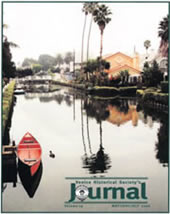 May/June/July 2006. Volume 20 May/June/July 2006. Volume 20
"Whatever Happened to the Lagoon and Canals"
'"I can't understand why anyone would prefer to live on a caved-in canal to living along a fine boulevard"
Venice Mayor C. Gordon Parkhurst in December 1924
"Keystone Beauties Victors in Great Bathing Parade at Venice"
Originally published on June 25, 1917
in MACK SENNETT WEEKLY
"Classy Canines in Venice"
An interest in Boston terriers and the purchase of a dog show medal on Ebay , sparked a recent question to the Venice Historical Society by a man in Kansas.
|
| |
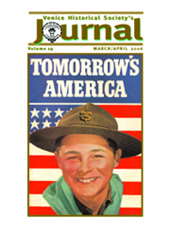 March/April 2006. Volume 20 March/April 2006. Volume 20
"Boy Scouting…Venice Style" By Scoutmaster Randy Overbeck
This article is about a unique Venice Boy Scout troop that was founded in 1924 and, after 82 years, Troop 34 continues to serve young men in the West Los Angeles Area.
Speaking of Pictures
Reprinted from LIFE Magazine, January 22, 1940
Abbot Kinney, once a cigarette millionaire, bought 100 acres of dunes, hired the world’s best architects and began to build ‘Venice-of-America.’
VHS Pays Tribute to a Special Person
Phil Parlett 1949-2006
An article paying tribute to a man whose volunteer organizations were his family, especially the Venice Historical Society, where Phil was a charter member.
|
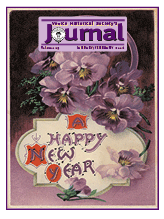 January/February 2006. Volume 20 January/February 2006. Volume 20
"Engine Company X"
'The Powerful Voice', a documentary film that covers the history of African-American firefighters from 1886 to the present time in Los Angeles.
Highlights of this history include the first African-American Firefighter, the integration battle and the modern age of firefighting. Additional history of the Los Angeles County Lifeguards is also covered.
Two films documenting the history of African-American Firefighters, The Powerful Voice (1886-1969) and
The New Stentorians (1970-2004) is on sale.
 November/December 2005. Volume 19 November/December 2005. Volume 19
"In Her Own Words" by Sonya Reese Davis
Three personalized accounts from the scrapbook of Sonya's grandfather
A Gorgeous Affair
The following article references The Venice Vanguard article of October,1914 which was titled: ³Halloween at Venice Dance Pavilion² My grandfather, Arthur Reese made himself into a festive decorator. This article referred to him as the "Wizard Reese", saying he had excelled
himself in decorating the pavilion with a Halloween theme. His style was to decorate not only the entrance and sides of the room,
but the rafters, buttresses and totally transform the place into the theme for that occasion. Filled with the childish enthusiasm of his two young sons, he designed an environment of ghostly wonder.
The article further described the "Release of the Spooks" as a beautiful feature. Tote Ducrow and his famous clown partners transformed themselves into witches along with fifty children who had taken part in a dance event that after noon. At the sound of a bugle call, the room was plunged into darkness, a spotlight lit the mouth of the Witches¹ caves placed on either side of the large center loge. A bugle announced the "spooks" were about to be released. All the "spooks" danced around wearing sheets. The competitors in the costume competition made their grand march out of the caves, the ladies in one direction and the gentlemen in the other until they formed a square around the bandstand. Cups were awarded to two people for each of the first, second, and third place winners. Exuberant crowds of people came from all around California to participate. The children¹s party, the competitions, events and the amusements were all overflowing with business. Dancers in the Venice Dance Pavilion forced the manager to keep the Pavilion open until 2:00 A.M. in the morning. The musicians in the orchestra directed by Mr. Lewis were nearly exhausted. Success merely refueled grandfather Reese. Aside from weekly signs, banners, and interior decorations, he had already started on plans for the yule time pageants and several floats he and his crew will construct for the Christmas parade and beyond that- New Years!.
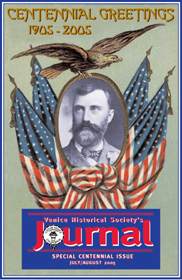 Jul/Aug 2005, Volume 19 Jul/Aug 2005, Volume 19
"Centennial Greetings: 1905-2005"
Happy 100 Year Anniversary to Venice!
Don't miss the Special Centennial Edition issue of the Venice Historical Society Journal, a photographic journey through the history of Venice.
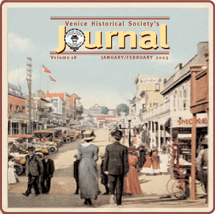 Jan/Feb 2005, Volume 19 Jan/Feb 2005, Volume 19
"This Was Pacific Electric"
This issue of the Venice Historical Society Journal includes an introduction to the film "This Was Pacific Electric" to be shown at the Jan 18 general
meeting.
The Venice Miniature Railway (part two)
By James Dent
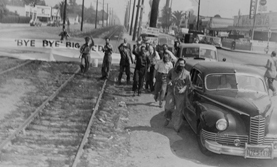 VMR #1 was designed by John J. Coit and built by the Johnson Machine Works
in Los Angeles in 1905. It is a 1/3 scale Prairie-class 2-6-2 wheel
layout. It operated on the rail line until February 23, 1925, when it was
shut down as a traffic menace. Locomotive #1 was sold to amusement tycoons,
Tom Prior and Fred Church in January, 1926. They sold it to a man in Denver,
Colorado in 1928. who said he was going to move it to Spokane, Washington,
which obviously never happened because later it was purchased by a Vernon
junkyard and used as a curbside attraction. VMR #1 was designed by John J. Coit and built by the Johnson Machine Works
in Los Angeles in 1905. It is a 1/3 scale Prairie-class 2-6-2 wheel
layout. It operated on the rail line until February 23, 1925, when it was
shut down as a traffic menace. Locomotive #1 was sold to amusement tycoons,
Tom Prior and Fred Church in January, 1926. They sold it to a man in Denver,
Colorado in 1928. who said he was going to move it to Spokane, Washington,
which obviously never happened because later it was purchased by a Vernon
junkyard and used as a curbside attraction.
In 1935, Al Smith bought the VMR #1 and in refurbishing it, was watched
by a boy named Don McCoy. Al Smith ran the engine #1 at several locations
in San Gabriel Valley, then moved operations to Steamland Park in Pico
Rivera. After Al Smith died and Steamland Park went bankrupt, Don McCoy
bought locomotive #1 and some cars from from the bankrupt park in 1969.
Don and his two sons spent three years restoring the old VMR #1, just as he
had watched Al Smith do years earlier. In 1972, he put it in operation at
the Whittier Narrows Recreation Area on an old 15-gauge miniature railway
right-of-way.
In 1978, due to vandalism, the city and county raising rent, and passing
an ordinance that he had to have a qualified steam engineer, he shut it down
and put it in his son�s garage. Just before he died, he gave the train to
his son, Jeff. It is still stored in the garage with two or three miniature
railroad passenger cars.
The Bill Jones Wildcat Railroad in Los Gatos is trying to buy VMR #1 so
they can have all three locomotives operating on the same tracks, but Jeff
McCoy does not want to sell.
For more information go to www.dogpile.com and www.yahoo.com and look up
Venice Miniature Railroad, Venice Railway Locomotives, Venice Miniature
Railway Postcards, Estate Park Scenic Railway, Billy Jones Wildcat Railroad
and Panama to Poly.
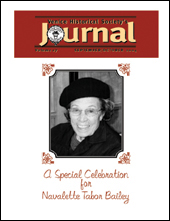 September/October 2004, Volume 18 September/October 2004, Volume 18
A Special Celebration for Navalette Tabor Bailey
Novie is Ninety! The cover of the Sept/Oct 2004 Journal as well as the General Meeting are devoted to the 90th birthday of our own Navalette Tabor Bailey.
Born in Morgan City, Louisiana, Navalette was brought to Venice at the
age of six months in 1915. She played in Oakwood as a child, went to Venice
High School and later worked helping her father, Charles Tabor, to fill in
the Venice-of-America canals in 1929, when he received the contract from the
City of Los Angeles.
She is a delightful lady and the vice-president of the Venice Historical
Society, where she has been an active board member since 1988.
Happy birthday Novie!
 July/August 2004, Volume 18 July/August 2004, Volume 18
"The Book of Sleep"
This issue of the Venice Historical Society Journal includes a book of poems
by John Thomas and Philomene Long. This will be the topic for our July 20 general
meeting.
|
|
Kinney's Memory - Part III (continued from May Journal)
by Tom Moran
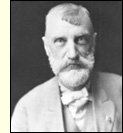 Abbot
Kinney had been reeling off a list of disasters, business mistakes
and financial failures that
had beset the little city of Venice-of-America. There had been the
highway that never was, the lectures that never enlightened, the storm
that practically erased his efforts before they had had a chance. Yet
his voice and expression showed no bitterness, no sign of defeat, no
trace of complaint. It seemed as if he was telling the story of another
man's mishaps. Not his own personal misfortune. Abbot
Kinney had been reeling off a list of disasters, business mistakes
and financial failures that
had beset the little city of Venice-of-America. There had been the
highway that never was, the lectures that never enlightened, the storm
that practically erased his efforts before they had had a chance. Yet
his voice and expression showed no bitterness, no sign of defeat, no
trace of complaint. It seemed as if he was telling the story of another
man's mishaps. Not his own personal misfortune.
"When we saw the mistake in the lecture course," he continued, "we
conceived of the idea of making Venice a musical center. We hired the
best band in the country - Ellery's - at a very heavy cost... no less
than $1000 to $1500 a week. Well, that was a failure too. Too expensive."
"Had it been cheaper music, it might have done better. Then we
got the idea of having music in a palm garden."
I modeled the
palm garden after some European gardens which are so popular, where
the people hear good music without being in a constrained and uncomfortable
attitude. It was another disappointment.
"The midway plaisance then came into existence."
"I supposed that they would exhibit interesting animals, perhaps
a gold mine, strange kinds of fish, that sort of thing. I had no idea
they would start side shows with "barkers." However it isn't
too bad."
"Sir," said the reporter, his pencil stopping for a brief
moment, "
do you mean you have stopped trying to attract the wealthy?"
Kinney cocked
his head toward the young man. "Understand," he said, "that
I never had any idea of making this a resort for rich people. The devil can
attend to the rich without assistance. And I really do think that we attracted
a very decent class of people."
"My idea now is to combine my original idea of the university
town with that of the popular resort."
"A man should have three parts to score success in life." Kinney
began counting them off on his long bony fingers. "First, he should
have the physique in connection with which I count the mind and intellect.
Second, he must have the moral character to carry out what his mind
directs. Third, the power of observation."
"The problem of education is to recognize and bring out all three.
It is a very hard problem. I want a school that will encourage all
three. I want part of the course to be outdoors."
"One of the new things for Venice will be a great aquarium, like
the one in the Battery in New York. David Starr Jordan [famous American
biologist and educator] has heard the plan and approved it. We will
have the greatest collection of Pacific fish in existence.
Do you know
that oysters actually grow in our canals- unplanted oysters. I have
found them and eaten them myself."
"We will keep the magnificent Japanese exhibit now in Venice and add to
it."
"Mr. Kinney," interrupted the reporter. "do you at
times wish you had never started with your plans? I mean with all the
disappointments and such."
"Do I wish I had never gone into it?' Kinney smiled a bit. "Why,
no, I think not. But why talk of that. We never can go back. The thing
is what is to be done now."
"A success, of course we shall make it a success. I haven't a
doubt of it. We have to do what the people will."
The reporter
stood up, "Mr. Kinney, I think we are about done. I have one last
question, if I may. What I wondered was, if you built this town as
an ideal and as a monument, why didn't you give it your own name?"
Kinney's
eyes lit up for a moment and a broad smile crossed his face. He did
not answer right away. Finally he spoke.
"Young man, there are about two billion and some millions of
people alive at the present time. They will die and be followed by
billions more. There are some pharoahs in Egypt that spent their lives
building pyramids that would serve to perpetuate their memories forever.
And people forgot how to read the language in which their achievements
were written.'
"What do you think the chances are for my being remembered?'
Abbot
Kinney, Venice's founder died in November of 1920, just weeks short
of his 70th birthday. His memory is evoked by the old buildings, the
fragments of the column-lined streets and the remnants of the canal
system that were his Venice-of-America. His memorials are few. |





 Celebrating over 32 Years!
Celebrating over 32 Years!






 WINTER/SPRING 2015. Volume 29.
WINTER/SPRING 2015. Volume 29. FALL 2014. Volume 28.
FALL 2014. Volume 28. SUMMER 2014. Volume 28.
SUMMER 2014. Volume 28. SPRING 2014. Volume 28.
SPRING 2014. Volume 28. WINTER 2014. Volume 28.
WINTER 2014. Volume 28.  SPECIAL EXTENDED ISSUE • SUMMER/FALL 2013. Volume 27.
SPECIAL EXTENDED ISSUE • SUMMER/FALL 2013. Volume 27.  SPRING 2013. Volume 27.
SPRING 2013. Volume 27.  WINTER 2013. Volume 27.
WINTER 2013. Volume 27.  FALL 2012. Volume 26.
FALL 2012. Volume 26.  SUMMER 2012. Volume 26.
SUMMER 2012. Volume 26.  SPRING 2012. Volume 26.
SPRING 2012. Volume 26.  WINTER 2012. Volume 26.
WINTER 2012. Volume 26. 
 SUMMER 2011. Volume 25.
SUMMER 2011. Volume 25.  SPRING 2011. Volume 25.
SPRING 2011. Volume 25.  WINTER 2011. Volume 25.
WINTER 2011. Volume 25.  FALL 2010. Volume 24
FALL 2010. Volume 24 SUMMER 2010. Volume 24
SUMMER 2010. Volume 24 SPRING 2010 - A SPECIAL ISSUE. Volume 24
SPRING 2010 - A SPECIAL ISSUE. Volume 24 WINTER 2010. Volume 24
WINTER 2010. Volume 24 FALL 2009. Volume 23
FALL 2009. Volume 23 SUMMER 2009. Volume 23
SUMMER 2009. Volume 23
 WINTER 2008-09. Volume 22
WINTER 2008-09. Volume 22 FALL 2008. Volume 22
FALL 2008. Volume 22 SUMMER 2008. Volume 22
SUMMER 2008. Volume 22 February/March/April 2008. Volume 22
February/March/April 2008. Volume 22
 August/September/October 2007. Volume 21
August/September/October 2007. Volume 21 May/June/July 2007. Volume 21
May/June/July 2007. Volume 21 Feb/Mar/Apr 2007. Volume 21
Feb/Mar/Apr 2007. Volume 21 Nov/Dec/Jan 2006-2007. Volume 20
Nov/Dec/Jan 2006-2007. Volume 20
 May/June/July 2006. Volume 20
May/June/July 2006. Volume 20 March/April 2006. Volume 20
March/April 2006. Volume 20
 November/December 2005. Volume 19
November/December 2005. Volume 19  Jul/Aug 2005, Volume 19
Jul/Aug 2005, Volume 19  Jan/Feb 2005, Volume 19
Jan/Feb 2005, Volume 19 VMR #1 was designed by John J. Coit and built by the Johnson Machine Works
in Los Angeles in 1905. It is a 1/3 scale Prairie-class 2-6-2 wheel
layout. It operated on the rail line until February 23, 1925, when it was
shut down as a traffic menace. Locomotive #1 was sold to amusement tycoons,
Tom Prior and Fred Church in January, 1926. They sold it to a man in Denver,
Colorado in 1928. who said he was going to move it to Spokane, Washington,
which obviously never happened because later it was purchased by a Vernon
junkyard and used as a curbside attraction.
VMR #1 was designed by John J. Coit and built by the Johnson Machine Works
in Los Angeles in 1905. It is a 1/3 scale Prairie-class 2-6-2 wheel
layout. It operated on the rail line until February 23, 1925, when it was
shut down as a traffic menace. Locomotive #1 was sold to amusement tycoons,
Tom Prior and Fred Church in January, 1926. They sold it to a man in Denver,
Colorado in 1928. who said he was going to move it to Spokane, Washington,
which obviously never happened because later it was purchased by a Vernon
junkyard and used as a curbside attraction. September/October 2004, Volume 18
September/October 2004, Volume 18 July/August 2004, Volume 18
July/August 2004, Volume 18  Abbot
Kinney had been reeling off a list of disasters, business mistakes
and financial failures that
had beset the little city of Venice-of-America. There had been the
highway that never was, the lectures that never enlightened, the storm
that practically erased his efforts before they had had a chance. Yet
his voice and expression showed no bitterness, no sign of defeat, no
trace of complaint. It seemed as if he was telling the story of another
man's mishaps. Not his own personal misfortune.
Abbot
Kinney had been reeling off a list of disasters, business mistakes
and financial failures that
had beset the little city of Venice-of-America. There had been the
highway that never was, the lectures that never enlightened, the storm
that practically erased his efforts before they had had a chance. Yet
his voice and expression showed no bitterness, no sign of defeat, no
trace of complaint. It seemed as if he was telling the story of another
man's mishaps. Not his own personal misfortune.